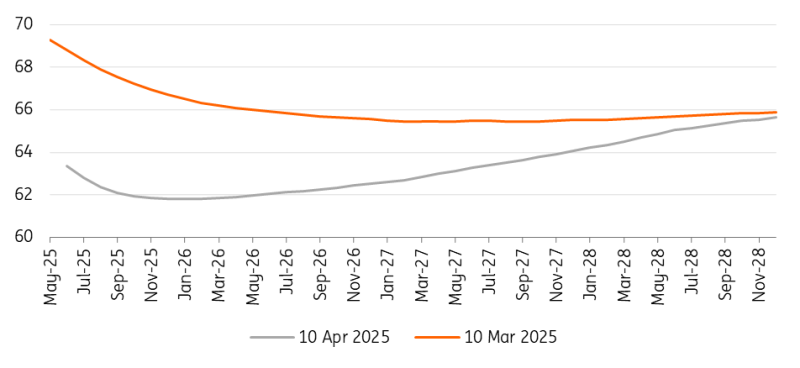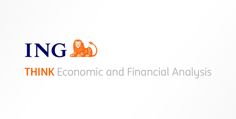Commodity markets are under significant pressure amid tariff threats. Uncertainty over how tense things could get is clouding the demand outlook. We’ve cut our forecasts
Oil Market Hit With Demand Uncertainty and Stronger Supply
The oil market is under significant pressure amid trade tensions. ICE (NYSE:ICE) Brent briefly broke below US$60/bbl last week, trading at the lowest levels since February 2021. While the Trump administration put a 90-day pause on reciprocal tariffs for most trading partners, the baseline 10% tariff remains, and the tit-for-tat on tariffs between the US and China has escalated.
It’s unclear where this escalation is going. The uncertainty is generating significant headwinds for global growth and, as a result, oil demand.
A rather odd decision by OPEC+ to increase supply in May by 411k b/d, more than the 135k b/d planned, hardly helped. OPEC+ tied the surprise increase to a positive market outlook, which we don’t agree with given growing demand uncertainties. There are suggestions that OPEC+ increased supply to punish members who’ve consistently been producing above their targets.
Or, possibly, President Trump was more successful than many thought in persuading the Saudis to increase supply. Yet, given the scale of the sell-off, we wouldn’t be surprised to see OPEC+ reverse this supply increase. Amid broader demand concerns, it may not be enough to reverse the trend.
For now, stronger OPEC+ supply and downside risks to demand leave the global oil balance more comfortable through the year.
We’ve revised our 2025 Brent forecast down to US$70/bbl from US$74/bbl last month. Our fourth quarter 2025 forecast is US$66/bbl. The environment is very fluid, though. Uncertainty abounds about whether we’ll see further revisions as the demand impact of tariffs becomes clearer.
The scale of the decline in oil prices will likely lead to a slowdown in drilling activity in the US. Producers, on average, need a WTI price of US$65/bbl to profitably drill a new well, according to the Dallas Federal Reserve Energy Survey. So, with West Texas Intermediate (WTI) trading around US$60/bbl, there’s little incentive for US producers.
Given falling drilling activity and high decline rates in US shale, it wouldn’t take too long for US oil production to start trending lower. So much for “drill, baby, drill”.
The tariff story is clearly overshadowing the sanction risks confronting the oil market. Lower prices might embolden the Trump administration to take a more aggressive approach in enforcing sanctions against Iran and Venezuela.
ICE Brent Forward Curve Pointing Towards a Better Supplied Market (US$/bbl)

Source: LSEG, ING Research
European Natural Gas Unable to Escape The Risk-Off Move
European natural gas is also getting caught up in the global risk-off trade. The Title Transfer Facility (TTF) has traded down to its lowest level since September 2024. Investment funds will continue to cut net longs in risk assets amid broader market uncertainty.
Demand for natural gas will also be a concern as tariffs pile up, particularly when it comes to industrial demand.
For now, fundamentals in the European gas market remain supportive. The EU finished the 2024/25 heating season with storage at a little under 34% full, well below 58% at the same stage last year and the five-year average of 45%. This leaves Europe with the tough task of hitting the European Commission’s storage target of 90% ahead of next winter.
The region will need to see the strongest net injections since 2022. We may need to see more flexibility on these targets, something that member countries are discussing.
Ceasefire talks between Russia and Ukraine appear to have stalled. As such, the prospect of a restart to some Russian pipeline gas flows to Europe looks even less likely, removing, or at least reducing, some downside risks to prices.
While TTF has been affected by the broader risk-off move, we’re reluctant to revise our forecasts lower for this year. The market is still set to be tight through 2025. We’ll need to see some tangible demand hits before making any aggressive downward revisions in our forecasts. We’re sticking to our EUR44/MWh TTF forecast for 2025.
Metals Tumble on Global Growth Fears
Since Trump’s reciprocal tariff announcements, global growth fears have come to dominate the narrative for metals markets. Although all base and precious metals, including gold, were exempted from new levies, there are concerns about a broader hit to the consumption of raw materials. The global trade war is bearish for copper and other industrial metals in the context of slowing global growth.
The impact of tariffs on China – the biggest consumer of metals – is particularly in focus for metals markets. Higher-than-expected US levies are likely to drag on Chinese growth and inflation this year.
With growth in the US likely to slow thanks to tariffs and China already struggling to revive its economy, demand for copper and other industrial metals is likely to weaken.
The question now is whether we’ll see more aggressive stimulus from Beijing. If so, this might limit the downside for copper and other industrial metals.
We expect the downtrend in metals to continue, at least in the short-to-medium term. This depends on the scope of US tariffs and how long they’re in place. If trade tensions intensify and we see more retaliatory measures, bearish sentiment could increase for industrial metals.
Among precious metals, gold is hitting fresh record highs after Trump’s U-turn on tariffs drove investors back to safe-haven assets. Despite the announced 90-day pause in reciprocal tariffs for most trading partners, duties on China were hiked. The possibility of a prolonged US-China trade war remains, and Trump’s plans could also change quickly.
This likely means more volatility for financial markets, which should continue to support gold. Gold is up by more than 20% so far this year, a record-breaking rally for the precious metal. Given the policy volatility surrounding Trump’s White House, we see uncertainty over trade and tariffs continuing to buoy gold prices.
Central bank buying, a bid to diversify reserves amid Trump’s unpredictable policies, is also expected to support gold prices.
Disclaimer: This publication has been prepared by ING solely for information purposes irrespective of a particular user’s means, financial situation or investment objectives. The information does not constitute investment recommendation, and nor is it investment, legal or tax advice or an offer or solicitation to purchase or sell any financial instrument. Read more
